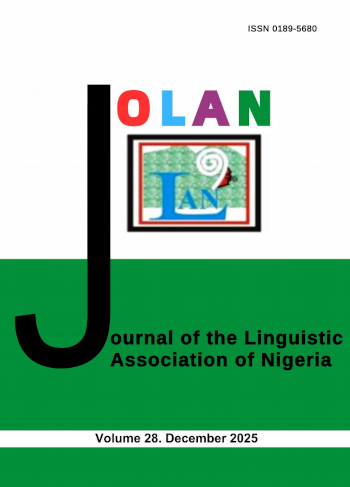Patterns of Negation in Ọrọ: A Morphosyntactic Analysis
Keywords:
Ọrọ language, circumfixation, prefix, suffix, sentential negationAbstract
The aim of this study is to analyse ‘one-word’ sentence negation patterns as well as sentential negation in Ọrọ, spoken in Akwa-Ibom state of Nigeria, within the principle and parameters framework. Negation which is a phenomenon in every language occurs when an affirmative sentence is reversed or negated. Cross linguistically, reversing the truth-value of a proposition requires the presence of a negative marker in the form of an affix or full word. For example, while English uses not to negate, negation in Ọrọ is achieved when negative morphemes are simultaneously prefixed and suffixed to the root verb predicate just like the French ‘Ne… pas’. However, the suffixed enclitics in the form of /ọu/, /ou/, /oo/, and /au/ are a necessary part of the negation process and they are movement sensitive and depend on preceding vowel sound which at times are copied and suffixed through the processes of circumfixation. Interestingly, the subject is left out before negation begins. Fourteen negative operators observed during this research are described. Data for the study were collected from primary and secondary sources in addition to the researcher’s intuitive knowledge of the language. Data analysed involves the present, past, future and imperative sentence forms. The study briefly compares patterns of negation of two other related languages, namely - Efik and Ibibio.
References
Akaduh, E. (1984) Ñsiñi Ọrọ: An intoduction to the study of the language of Oro, Nigeria. Oro: Manson Publishing Company.
Anyanwu, R-J (2007) Fundamentals of Phonetics, Phonology and Tonology with specific African sound Patterns. Germany: Frankfurt am main
Belleti, A. (1990) Generalized Verb Movement. Rosenberg and Sellier: Turin
Burton-Roberts, N. (2007) Varieties of semantics and encoding negation, narrowing/loosening and
numerical. In Noel Burton-Roberts (ed), Pragmatics, 90-114. Baasingstoke: Palgrave.
Crystal, D. (2001) The Cambridge Encyclopaedia of the English Language, UK: CUP
Ejele, P. E. (1995) The Semantic of Negation. In Emenanjo E. N & Ndimele, O. M. (eds) Essay in Honour of Kay Williamson. National Institute for Nigerian Languages, Aba: Nigeria.
Essien, O. E. (1985) Negation in Ibibio: A Syntactic-Phonological Process. Journal of West African Languages XV:I, 73-92
Essien, 0. E. (1990) A Grammar of the Ibibio Language, Calabar: United Press Limited
Greenberg, J. H. (1963) The Languages of African. The Hague: Bloomington Mouton & Co.
Katamba, F. (1989) An Introduction to Phonology. London: Longman
Klima, E. S. (1964) Negation in English. In Fodor, J. A. and J. J. Katz (eds.). The Structure of Language. Englewood Cliffs, New Jersey: Prentice Hall Inc.
Ndimele, O. M. (1995) On the Phonosyntactic Dimension of Negation. In Emenanjo E. N & Ndimele, O. M. (eds) Essay in Honour of Kay Williamson. National Institute for Nigerian Languages, Aba: Nigeria.
Ngonyani, D. (2001) “The Morphosyntax of Negation in Kiswahili” Afrikanistische Arbeitspapiere, Swahili Forum VIII:17-33
Pike K. (1948) Tone Languages. Ann Arbor: University of Michigan Press.
Pollock, J. Y. (1989) “Verb Movement, Universal Grammar and the Structure of IP” Linguistic Inquiry 20:364-424
Quirk, R. and S. Greenbaum (1973) A University Grammar of English. London: Longman Tanda,V. A. & Neba, A. N. (2005) Negation in Mokpe and two related Coastal Bantu Languages of Cameroon. Asian Study of Monograph, (26 (4) 201-219.
Uya, O. E. (1984) A History of Oron people of the Lower Cross River Basin, Oron: Manson Publishing Company














